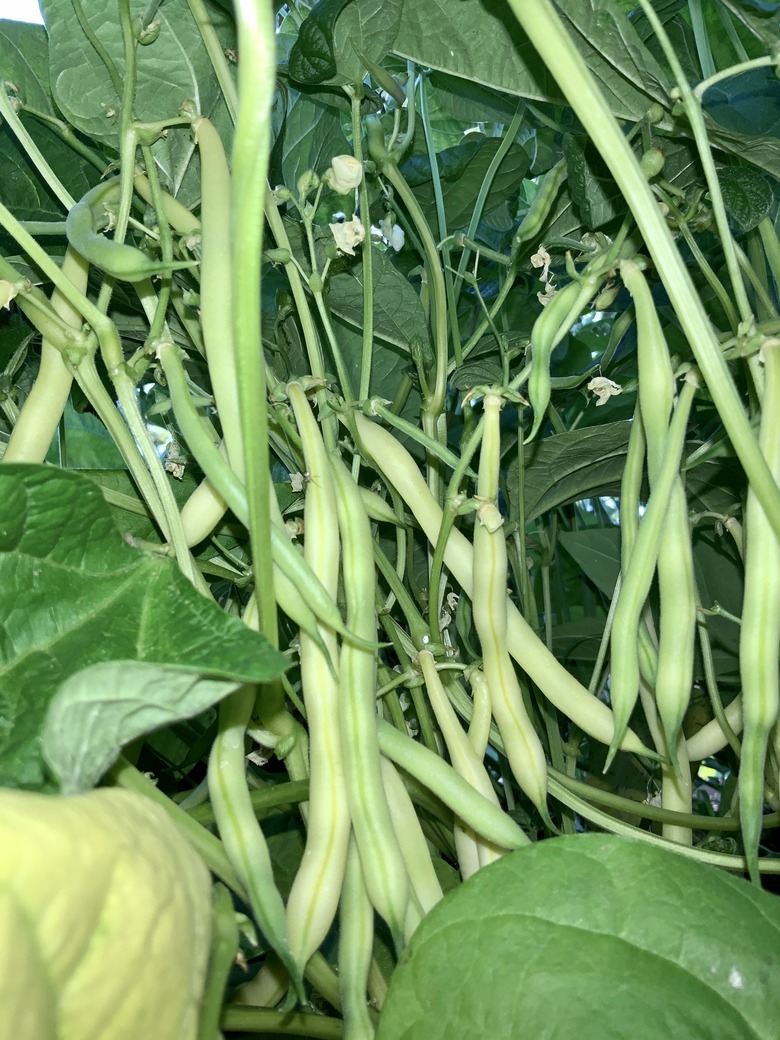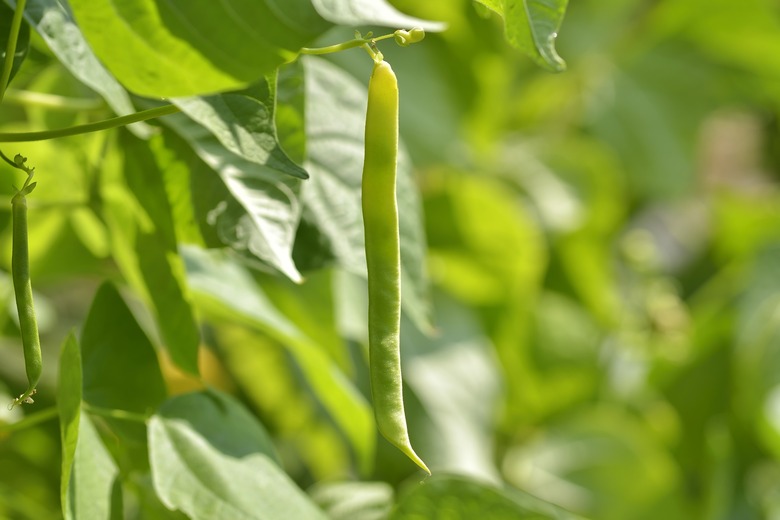How To Grow Bush Beans
We may receive a commission on purchases made from links.
- Best uses for bush beans
- How to grow bush beans
- In what zone do bush beans grow best?
- When should you sow bush beans?
- Soil, sunlight and water recommendations for bush beans
- How to winterize bush beans
- How to harvest bush beans
- Common pests and other problems for bush beans
- Common diseases for bush beans
If you love homegrown green beans (Phaseolus vulgaris) but don't want to mess with a trellis, bush beans are the plant for you. Pole beans are green beans that grow on a vine-like, top-heavy plant that needs a trellis for support. Bush beans, however, stay small and spport themselves, making a trellis unnecessary.
Bush beans taste every bit as good as pole beans but stay short and round, reaching only about 2 feet in height. Bush beans do produce fewer beans than their pole bean counterparts, but you're still likely to get more beans than you can eat, so prepare to freeze, pickle, can or gift your excess harvest.
Bush beans go from seed to harvest in around 50 to 55 days, often coming in all at once. If you want to keep picking green beans all summer, plant multiple bush beans two weeks apart. Stop planting about 60 days before your area's first expected frost.
Best Uses for Bush Beans
Best Uses for Bush Beans
Bush beans aren't fancy or decorative, but they are practical. Vegetable gardeners grow bush beans solely for the pods they produce. They're good for new gardeners since they're easy to grow, and many experienced gardeners consider them a summer vegetable staple. You can even plant them in containers if you're short on gardening space.
Green beans also freeze extremely well. If you miss your homegrown veggies during the winter, plant some bush beans and freeze them at harvest time. You can then enjoy the taste of fresh, homegrown vegetables all year long.
How to Grow Bush Beans
How to Grow Bush Beans
- Common Name: Bush bean
- Botanical Name: Phaseolus vulgaris
- When to Plant: Wait until nighttime soil temperatures reach 70 degrees Fahrenheit or higher
- USDA Zones: Grown as an annual in zones 3-10
- Sun Exposure: Full sun
- Soil Type: Moist, well-drained soil
- When it's in Trouble: Discoloration, floppy stems, poor growth
- When it's Thriving: Sturdy, leafy plant with deep-green leaves
Starting Bush Beans From Seed
Bush beans have very shallow and delicate roots that don't take kindly to being handled. Even if you're extremely careful when moving them, most bean plants die when you try to transplant them. Because of this, you'll want to sow your green bean seeds directly in the garden rather than starting them indoors in seed trays.
Sow your seeds about 1 inch deep, spacing them 18 to 24 inches apart. If you're planting your beans in a container or in raised beds, keep the seeds at least 2 inches away from the sides. Cover your seeds with soil and then gently pat the earth to make sure your seeds make full contact with the soil around them.
Water your newly planted seeds gently so as not to dislodge them. You should see seedlings start to emerge in about eight to 10 days.
In What Zone Do Bush Beans Grow Best?
In What Zone Do Bush Beans Grow Best?
As a warm-season vegetable, bush beans will grow almost anywhere, thriving in USDA zone 3 through 10. No matter where you grow these annual plants, they will enjoy a warm growing season, produce their harvest and then die. You can plant bush beans in your garden again next year, but you'll need to start over again with fresh seeds.
When Should You Sow Bush Beans?
When Should You Sow Bush Beans?
Wait to sow your bush beans until after the last frost has passed and the soil stays a comfortable 70 degrees at night. Southern gardeners can get a jump on the growing season, sowing their beans as early as the end of April. Those in colder climates may need to wait until early June when the danger of frost is gone, however.
Like pole beans, bush beans self-pollinate. This means that you can grow bush beans indoors at any time if you wish.
Soil, Sunlight and Water Recommendations for Bush Beans
Soil, Sunlight and Water Recommendations for Bush Beans
Like other green beans, bush beans are generally labeled as needing full sun. This can mean different things in different places, however. Bush beans need six to eight hours of direct sunlight a day. If you live in the South where the plant could easily get more sun than that, rest assured that your beans will tolerate and may even appreciate some afternoon shade.
Bush beans like well-draining, slightly acidic soil with a pH level of 6 to 6.8. Test your soil's pH level before planting. If it's below 5.8, add a bit of lime. You can fertilize your beans by adding compost to the soil before you plant them or side-dressing them with a granular fertilizer after they bloom. Choose a fertilizer that is low in nitrogen when fertilizing beans. Bean plants are quite adept at making their own nitrogen, so giving them more can be overkill. Plants that receive too much nitrogen will be lush and leafy but will produce very few beans.
Mulch around your beans when the seedlings are tall enough to protect your plants' shallow roots and to help prevent weeds. Keep a close eye out for weeds that do take hold and remove them promptly. If you allow the weeds to root deeply close to your beans, you could damage the shallow roots of your bean plants while removing the weeds. It's best to catch the weeds early.
Bush beans need 2 to 3 inches of water per week during the growing season. You can supplement their water if Mother Nature fails to provide adequate rainfall but do so carefully. Wet bean plant leaves are a haven for various fungi and bacteria, so water at the base of your plants and try to avoid soaking the foliage. One way to do so is by digging a shallow trench next to your bean plants, filling it with water and allowing the water to soak into the ground around your beans.
How to Winterize Bush Beans
How to Winterize Bush Beans
Bush beans are annual plants, and there is no way to carry a plant from one growing season to the next. You'll have no choice but to sow fresh bean seeds next year. Even if you grow your beans in a container and bring them inside when the weather turns cold, your plants will die back after they're done producing for the season.
You can, however, grow bush beans indoors during the winter. To do so, you'll need to give them all the same things they get outside. Plant them in a large container of well-draining soil and place them in a warm area where they'll get six to eight hours of sun per day. If you can't provide adequate sunlight naturally, place the plants under a grow light instead.
Give them the 2 or 3 inches of weekly water they crave and then harvest your beans when they're ready just as you would if you grew the plants outdoors. Unfortunately, the plant will still die when it's done producing, but you can always grow another.
How to Harvest Bush Beans
How to Harvest Bush Beans
Harvest your beans when they're the diameter of a pencil and about 4 to 6 inches long. Once you start harvesting your beans, don't stop because the more beans you pick, the more your plant will produce. Bush beans won't produce as long as pole beans but will still give you a more bountiful harvest if you pick often while you can.
Try to pick in the morning if you can because beans hold more sugar then. Beans that stay on the vine too long will start to bulge, growing tough and bitter. Pull these beans off the plant so that it keeps producing but instead of eating them, compost or dispose of them.
Common Pests and Other Problems for Bush Beans
Common Pests and Other Problems for Bush Beans
Deer, rabbits and even woodchucks will feast on bush beans if allowed. To keep them out, fence your garden or surround it in chicken wire. Your fencing needs to be 6 feet tall if you want to keep deer out.
When it comes to insects, aphids and beetles prove to be the most problematic where bush beans are concerned. If you see a few beetles on your beans, simply pick them off by hand and drop them into some soapy water. If there's too many to remove by hand, simply spray the bugs away with your garden hose.
Common Diseases for Bush Beans
Common Diseases for Bush Beans
Bush beans are subject to diseases such as white mold, mosaic virus, anthracnose and bean blight. To avoid all of these conditions and others, rotate your bean crops rather than planting your beans in the same spot year after year. Leave adequate room around your plants for air circulation as well.
Water at the base of your plants but try to avoid getting the foliage wet and don't harvest or work with your bean plants while they are wet with irrigation rainwater. Doing so can accidentally spread fungi and bacteria from one plant to another.
If you see a bean plant start to wilt or look unhealthy, remove and destroy it before it can affect other plants. If fungi or bacteria have already spread to most of your plants, you'll need to treat them.
You can combat fungal and bacterial poblems with a copper fungicide or chlorothalonil. Apply your chosen treatment according to the package directions. You'll typically need to reapply the treatment at seven- to 10-day intervals.
Whenever you are fighting a plant disease, consider consulting your local garden center or agricultural extension. The experts there will know exactly what plant problems are prevalent in your area and how to safely treat them on food crops.
References
- Savvy Gardening: Growing Green Beans: Learn How to Plant, Grow, and Harvest a Bumper Crop of Green Beans
- Southern States: How to Grow Bush Beans
- Gardener's Path: How to Grow Bush Beans
- Gardener's Path: Full Sun Doesn't Always Mean Full Sun
- The Old Farmer's Almanac: Growing Green Beans
- Burpee: Growing Beans – Pole or Bush
- Clemson Cooperative Extension: Bean & Southern Pea Diseases


